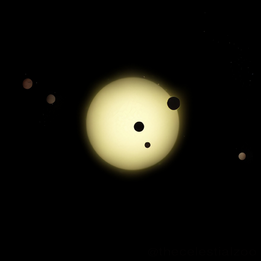Astronomy:Tau Ceti f
 Artist's interpretation of Tau Ceti with planets | |
| Discovery | |
|---|---|
| Discovery date | December 19, 2012 |
| Doppler spectroscopy | |
| Orbital characteristics | |
| 1.334 au | |
| Eccentricity | 0.16 |
| Orbital period | 1.7 y |
| Star | Tau Ceti |
| Physical characteristics | |
| Mean radius | ~1.81 R⊕ (estimate)[1] |
| Mass | ≥3.93 M🜨 |
Tau Ceti f is a potential super-Earth[2] or mini-Neptune orbiting Tau Ceti that was discovered in 2012 by statistical analyses of the star's variations in radial velocity, based on data obtained using HIRES, AAPS, and HARPS. It is of interest because its orbit places it in Tau Ceti's extended habitable zone,[3][4] but a 2015 study implies that there may not be a detectable biosignature because it has only been in the temperate zone for less than one billion years.[5][6] In 2017, it was again recovered from radial-velocity data, along with Tau Ceti e. Despite this, it remains an unconfirmed candidate.[7]
Characteristics
Few properties of the planet are known other than its orbit and mass. It orbits Tau Ceti at a distance of 1.35 AU (roughly Mars's perihelion in the Solar System) with an orbital period of 642 days, and has a minimum mass of 3.93 Earth masses.[7] However, if it and its companion planets were similarly inclined to Tau Ceti's debris disk at 35±10°, f could 5.56+1.48
−1.94 and 9.30+2.48
−3.24 Earth masses, which means it's slightly more likely to be a mini-Neptune, although the exoplanet is included in the conservative sample of potentially habitable exoplanets.[8] It is estimated to be 1.81 Earth radii.[1]
Habitability
As of October 2020, Tau Ceti f is considered the most potentially habitable exoplanet orbiting a Sun-like star.[9] Its neighbor, Tau Ceti e, was previously regarded as a potentially habitable exoplanet in the conservative sample, but it was determined to likely be too hot to hold life, more similar to Venus.[10] It and its companion may suffer from a continuous bombardment of asteroids, up to 10 times higher than in the Solar System,[11] but a conjectured (super-)Jovian planet as outlined in a 2019 Astronomy & Astrophysics paper may be shepherding the disk, as it may be as close as 3 AU and as far away as 20.[12]
With a flux of 0.32 the flux on Earth, Tau Ceti f has an estimated equilibrium temperature of only 190 Kelvin. If the conditions were the same as on the Earth, Tau Ceti f's average temperature would be around -50 °C. However, with a thicker atmosphere and a larger ocean, the temperature could be similar to Earth's.[13]
See also
References
- ↑ Jump up to: 1.0 1.1 "Exoplanet-catalog". https://exoplanets.nasa.gov/exoplanet-catalog/7180/tau-ceti-f/.
- ↑ "Exoplanet-catalog". https://exoplanets.nasa.gov/exoplanet-catalog/7180/tau-ceti-f/.
- ↑ "Two Nearby Habitable Worlds? - Planetary Habitability Laboratory @ UPR Arecibo". http://phl.upr.edu/press-releases/twonearbyhabitableworlds.
- ↑ "Four Exoplanets Detected around Nearby Star Tau Ceti | Astronomy | Sci-News.com" (in en-US). http://www.sci-news.com/astronomy/tau-ceti-exoplanets-05117.html.
- ↑ April 2015, Mike Wall 24 (24 April 2015). "Nearby Alien Planets Not So Life-Friendly After All" (in en). https://www.space.com/29191-exoplanets-tau-ceti-alien-life.html.
- ↑ Pagano, Michael; Truitt, Amanda; Young, Patrick A.; Shim, Sang-Heon (2015-04-21). "THE CHEMICAL COMPOSITION OF τ CETI AND POSSIBLE EFFECTS ON TERRESTRIAL PLANETS". The Astrophysical Journal 803 (2): 90. doi:10.1088/0004-637X/803/2/90. ISSN 1538-4357. https://iopscience.iop.org/article/10.1088/0004-637X/803/2/90.
- ↑ Jump up to: 7.0 7.1 Feng, Fabo; Tuomi, Mikko; Jones, Hugh R. A.; Barnes, John; Anglada-Escude, Guillem; Vogt, Steven S.; Butler, R. Paul (2017-09-05). "Color difference makes a difference: four planet candidates around tau Ceti". The Astronomical Journal 154 (4): 135. doi:10.3847/1538-3881/aa83b4. ISSN 1538-3881. Bibcode: 2017AJ....154..135F.
- ↑ "The Habitable Exoplanets Catalog - Planetary Habitability Laboratory @ UPR Arecibo". http://phl.upr.edu/projects/habitable-exoplanets-catalog/.
- ↑ "The Habitable Exoplanets Catalog - Planetary Habitability Laboratory @ UPR Arecibo". http://phl.upr.edu/projects/habitable-exoplanets-catalog/.
- ↑ "Two Nearby Habitable Worlds? - Planetary Habitability Laboratory @ UPR Arecibo". https://sites.google.com/a/upr.edu/planetary-habitability-laboratory-upra/press-releases/twonearbyhabitableworlds.
- ↑ "Death Down Asteroid Alley" (in en-US). 2004-07-02. https://www.astrobio.net/meteoritescomets-and-asteroids/death-down-asteroid-alley/.
- ↑ Kervella, Pierre; Arenou, Frédéric et al. (2019). "Stellar and substellar companions of nearby stars from Gaia DR2". Astronomy & Astrophysics 623: A72. doi:10.1051/0004-6361/201834371. ISSN 0004-6361. Bibcode: 2019A&A...623A..72K. ""We also detect the signature of a possible planet of a few Jovian masses orbiting τ Ceti…The observed signal could be explained for example, by a Jupiter analog orbiting at 5au."".
- ↑ "Open Exoplanet Catalogue - tau Ceti f". http://openexoplanetcatalogue.com/planet/tau%20Ceti%20f/.
 |

